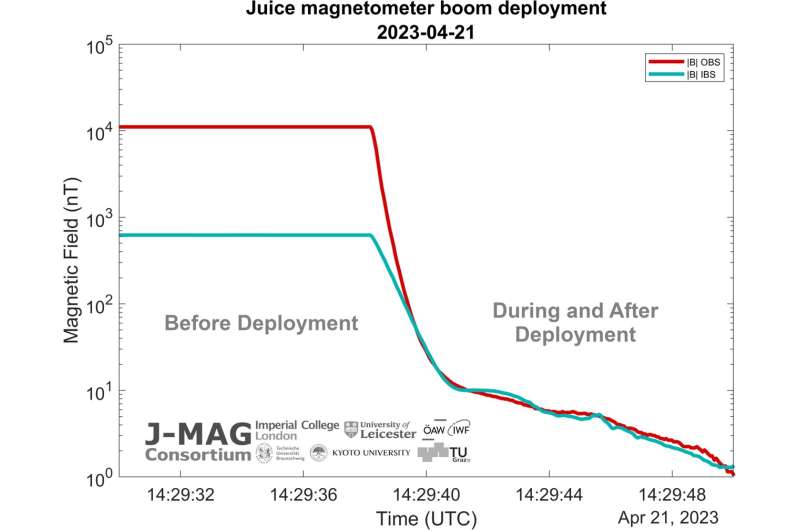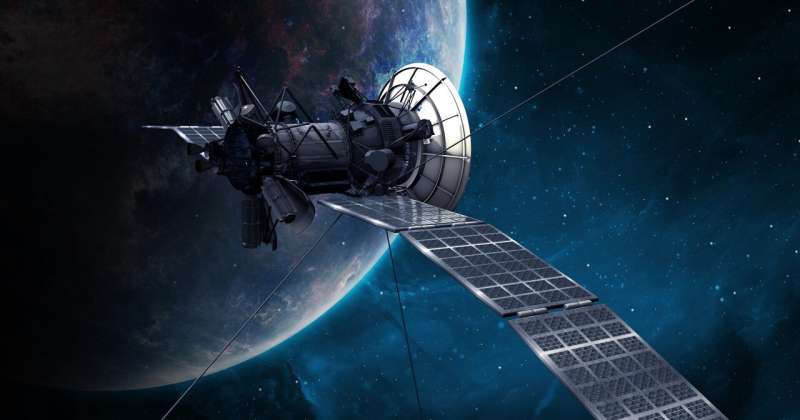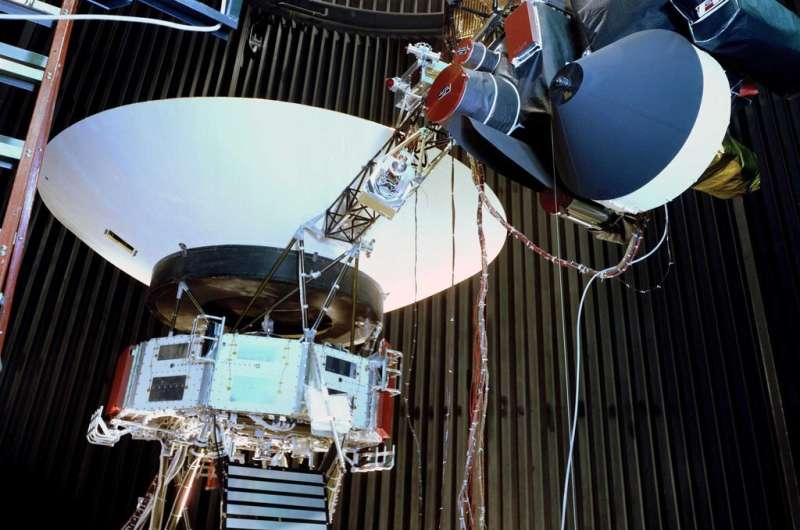
Copernical Team
Fish and Wildlife: SpaceX Starship debris covered 350 acres, no wildlife killed
 The U.S. Fish and Wildlife Service documented the fallout from the SpaceX rocket that exploded in the Gulf of Mexico last week, scattering debris into the surrounding area.
The service said "no dead birds or wildlife" or debris from the spacecraft launch were found on lands belonging to the Lower Rio Grande Valley National Wildlife Refuge, stating the greatest impact came in the form of
The U.S. Fish and Wildlife Service documented the fallout from the SpaceX rocket that exploded in the Gulf of Mexico last week, scattering debris into the surrounding area.
The service said "no dead birds or wildlife" or debris from the spacecraft launch were found on lands belonging to the Lower Rio Grande Valley National Wildlife Refuge, stating the greatest impact came in the form of Jupiter Icy Moons Explorer's first taste of science from space

ESA's Jupiter Icy Moons Explorer, Juice, has recorded magnetic field data as its 10.6 m-long magnetometer boom deployed.
Juice launched on 14 April, with deployments and activation of its antennas, booms, sensors and instruments ongoing over the next months in a dedicated check-out period known as the commissioning phase.
The Juice magnetometer boom (J-MAG) was deployed on 21 April, when Juice was about 1.7 million km from Earth.
Data collected by J-MAG captured the moment of deployment itself.
The plot shows the magnitude of the magnetic field from two sensors, as indicated by the red and turquoise lines, before (flat line) and during the deployment (curving lines). The two sensors are mounted on the outer segment of the boom and separated by about 3 m. The labels OBS and IBS indicate the data from the outboard (OBS) and inboard sensors (IBS), respectively. OBS is mounted close to the end of the 10.6 m boom.
The left side of the plot shows the field trace before the boom deployment. The sensors are up against the side of the spacecraft and OBS is located close to two spacecraft thrusters, which are quite magnetic, explaining the difference in the two field magnitudes.
Could you be ESA’s official merchandise supplier?

ESA is inviting companies with an interest in merchandising to submit a tender to become the space agency’s official ESA-branded merchandise supplier.
Sustainability in space—can you teach old satellites new tricks?

We've all heard that we should "Reduce, Reuse, Recycle" to save the planet, but what about applying any of the "three R's" to space?
Researchers at USC Viterbi's Information Sciences Institute (ISI) are tackling this challenge—looking at how to reuse physical items that are already in space, namely, old satellites.
Legacy Satellites
There are currently several thousand satellites orbiting Earth. Many have already completed their missions or have outlived their primary lifespans—these are "legacy satellites." And while some of them may have broken hardware and will eventually run out of energy, leave orbit, and burn out in space, others are physically in good condition. So, the question becomes: what to do with them?
Alefiya Hussain, ISI Research Team Leader explained, "This project is looking at ways to possibly reuse satellites for different things. We are collaborating with the software company Tangram Flex to figure out how we can replace the software components within the satellites to re-purpose them."
She continued, "The approach we've taken is to look inside the satellite and say, this particular piece of software did this particular function before, can we actually replace that function to make it do something else as a path to repurposing it?"
NASA's Voyager will do more science with new power strategy

The plan will keep Voyager 2's science instruments turned on a few years longer than previously anticipated, enabling yet more revelations from interstellar space.
Launched in 1977, the Voyager 2 spacecraft is more than 12 billion miles (20 billion kilometers) from Earth, using five science instruments to study interstellar space.
Arianegroup, Eutelsat And Magellium Selected To Improve French Space Surveillance Capabilities
 ArianeGroup, Eutelsat and Magellium have won a contract from the French space agency (CNES), as part of the space component of the France 2030. Investing for the Future plan, with the aim of enhancing space surveillance capabilities in order to substantially improve the security of space operations.
The consortium will provide CNES with a Space Situational Awareness (SSA) data service thro
ArianeGroup, Eutelsat and Magellium have won a contract from the French space agency (CNES), as part of the space component of the France 2030. Investing for the Future plan, with the aim of enhancing space surveillance capabilities in order to substantially improve the security of space operations.
The consortium will provide CNES with a Space Situational Awareness (SSA) data service thro Another giant leap into space: Successful launch of Lumelite-4 to enhance maritime communications
 A microsatellite for maritime communications developed by the Satellite Technology And Research Centre (STAR) under the National University of Singapore's College of Design and Engineering (NUS CDE), and A*STAR's Institute for Infocomm Research (I2R), has been successfully launched from the Satish Dhawan Space Centre in Sriharikotta, India, on Saturday, 22 April 2023 at 4.50pm (Singapore time).
A microsatellite for maritime communications developed by the Satellite Technology And Research Centre (STAR) under the National University of Singapore's College of Design and Engineering (NUS CDE), and A*STAR's Institute for Infocomm Research (I2R), has been successfully launched from the Satish Dhawan Space Centre in Sriharikotta, India, on Saturday, 22 April 2023 at 4.50pm (Singapore time). CGI to extend machine learning to LEO satellite network optimisation
 CGI (NYSE: GIB) has been awarded a further contract by the European Space Agency (ESA) under ESA's ARTES Core Competitiveness program, with the support of the UK Space Agency, to expand the development of its Dynamic Predictive Routing (DPR) tool.
The tool uses machine learning to enhance the routing of traffic in dynamic networks in Low Earth Orbit (LEO), especially those incorporating la
CGI (NYSE: GIB) has been awarded a further contract by the European Space Agency (ESA) under ESA's ARTES Core Competitiveness program, with the support of the UK Space Agency, to expand the development of its Dynamic Predictive Routing (DPR) tool.
The tool uses machine learning to enhance the routing of traffic in dynamic networks in Low Earth Orbit (LEO), especially those incorporating la Framework for Roman Spacecraft moves to Goddard clean room
 The primary structure that will serve as the "bones" of NASA's Nancy Grace Roman Space Telescope has moved into the big clean room at NASA's Goddard Space Flight Center in Greenbelt, Maryland. The spacecraft bus, Roman's primary support element, will now be built upon this skeletal framework. When it launches by May 2027, Roman will help unravel the secrets of dark energy and dark matter, search
The primary structure that will serve as the "bones" of NASA's Nancy Grace Roman Space Telescope has moved into the big clean room at NASA's Goddard Space Flight Center in Greenbelt, Maryland. The spacecraft bus, Roman's primary support element, will now be built upon this skeletal framework. When it launches by May 2027, Roman will help unravel the secrets of dark energy and dark matter, search Milky Way's fate? Astronomers reveal what ignites quasars
 Astronomers said Wednesday that for the first time they have confirmed what ignites quasars, the brightest and most powerful objects in the universe, which put galaxies in their "death throes".
These celestial behemoths form when two galaxies smash into each other, the astronomers said, warning that this could be the Milky Way's fate in a few billion years.
Quasars are one of the most ex
Astronomers said Wednesday that for the first time they have confirmed what ignites quasars, the brightest and most powerful objects in the universe, which put galaxies in their "death throes".
These celestial behemoths form when two galaxies smash into each other, the astronomers said, warning that this could be the Milky Way's fate in a few billion years.
Quasars are one of the most ex 